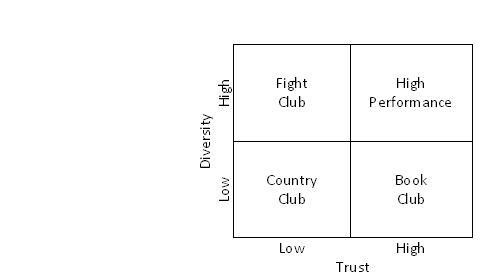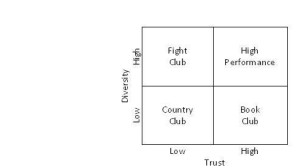
Ensuring Inclusion – A Pulse Check
Here is a common scenario we encounter in assessing employee engagement and implementation of change management projects….
I have a very high degree of trust with person #1. I also think very similarly and have had many years of shared experience with him. But person #2 thinks very differently than I do—she brings an alternate perspective and often disagrees with me. I am suspicious of her motives because they are different from mine, but she too is bringing value to the team.
Unfortunately, many teams get to the speed of trust the wrong way, the “cheating” way—they remove people who think differently. The result is a team with higher trust, but at a very damaging cost—the reduction of diversity. If teams want to achieve high performance, they need to do the very hard work of creating trust and engagement among people with different perspectives.
The following grid shows the interplay of trust and diversity.
There is no question that teams with low trust have sub-optimal performance. But there are two different scenarios depending on whether these low trust teams have high or low diversity.
In the high diversity/low trust scenario, things can get a little rough. Team members can be rigid and accusatory. Voices are often raised but few people are really listening. I think of a team like that as a “Fight Club.” If you find yourself on a team like this, the good news is that you already have diverse perspectives and it is possible to build trust. It could be worse…
What does worse look like? Sometimes a team has neither diversity nor trust. That feels a lot like the “Country Club.” Everyone looks and thinks alike, but the lack of trust manifests in gossip and cliques. Conflict is never out in the open. Nothing ever moves forward.
In contrast, there are teams with high levels of trust. Again, the team experience is different depending on whether or not they engage diverse perspectives within the team or not. When teams have high trust but little diversity, I think of them as like a “Book Club.” There is certainly high trust, but the lack of diversity means the conversation can be superficial.
The magic occurs when there is both diversity AND trust. The result is truly amazing to watch. The team debates issues fully. They listen to one another and the final decision reflects the value of all team members.
So if you want your team to reap the benefits of the speed of trust, don’t get there by “culling the herd” of people who think differently. That might make things fast, but it will leave the team weaker and with much greater risk. Instead, engage in the hard work of building trust among team members who think differently. Then you get the speed of trust and the quality of diversity.
Back to the opening scenario…I guess I have some work to do with Person #2 to hear them out and engage them in building the solution together.

